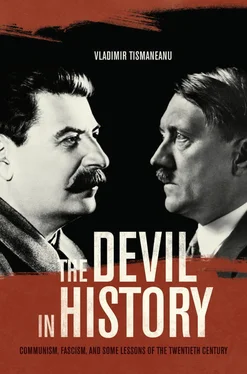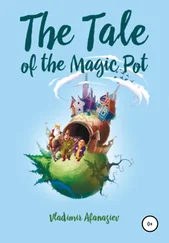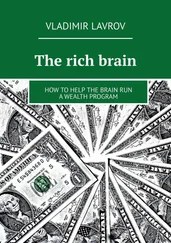Political practice was the area where the citizen came to terms with the deliberately ideological lived environment. Under the circumstances, terror could be used to refer to “a complex sensibility of existential dislocation that affects the population broadly under totalitarian rule.” 48Stalinism and Nazism were “states of terror” (as Overy puts it) because they tried to achieve homogenization by creating “battle communities” (in the words of Fritzsche) within which already existent differences were the subject of grotesque public dramatization and the object of elimination through “capillary organization” (Gentile’s term) and constant mobilization. Collective and individual dislocation under conditions of state mobilization and state violence generated new social realities that sustained both genocide and a sense of belonging and unity in “fractured (German) and quicksand (Soviet) societies” (Geyer). Both of them were “extreme consequences of secular humanism” (Gentile) echoing the disillusionment and despair brought on by the traumatic experience of the Great War. 49
Fascism and Communism, as political movements, were resolutions to a painfully and universally felt “sense-making crisis” throughout Europe. 50Born out of the cataclysmic barbarism and unprecedented violence of World War I, these apocalyptical movements proclaimed the advent of the millennium in this world or, to use political philosopher Eric Voegelin’s formulation, they tried to immanentize the eschaton, to build Heaven on Earth, to eliminate the distinction between the City of Man and the City of God. 51Between 1914 and 1918, “in four years the belief in evolution, progress and history itself was wiped out” as the war “ripped up the historical fabric and cut everyone off from the past suddenly and irretrievably.” 52Communism and Fascism were reactions to this perceived anomy. They were attempts to give birth to a new sense of transcendence and belonging. From this point of view, they were, as Roger Griffin insightfully remarked, radical political modernisms.
IDEOLOGY AND INTENTIONALITY
The official Communist creed was rationalistic and lionized the legacies of the Enlightenment, while the Nazi ideologues (Alfred Rosenberg, Joseph Goebbels, Alfred Baumler, Otto Strasser) insisted on the power of irrational, vital energies and scorned the allegedly sterilizing effects of reason. The reality was that, underneath the ostensible philosophical incompatibilities between the two rival ideologies, Nazism contained a number of tactical affinities with the much-decried Marxism. Hitler himself admitted that he found inspiration in Marxist patterns of political struggle: “I have learned a great deal from Marxism, as I do not hesitate to admit. I don’t mean their tiresome social doctrine or the materialist conception of history,… and so on. But I have learned from their methods. The difference between them and myself is that I have really put into practice what these peddlers and pen-pushers have timidly begun. The whole National Socialism is based on it… National Socialism is what Marxism might have been if it could have broken its absurd and artificial ties with the democratic order.” 53
It is well known that there are scholars who resist the very idea of a comparison between Communism and Fascism. Comparison can (but not always does) diminish the uniqueness of the absolute horror symbolized by the Holocaust and can overlook the fact that the ideological intentions were significantly different between the Communist and Fascist, or rather, Nazi, projects. Still, both were revolutionary ideologies that aimed to destroy the status quo (that is, the bourgeois order) and its enshrined values. Both movements proclaimed the leading role of a community of chosen individuals grouped within the party. Both detested bourgeois values and liberal democracy. One carried to an extreme a certain Enlightenment universalism, the other made an absolute of racial particularism. Lenin did not nourish xenophobic propensities, but Stalin did. At the end of his life, Stalin behaved like a rabid anti-Semite and prepared horrific pogroms. Both Hitler and Stalin used propaganda to dehumanize their enemies, the Judeo-Bolsheviks, the Trotskyites, and the Zionists. Fascism and Communism equally put themselves in position to “blast a specific era out of the homogeneous course of history.” 54They both aimed to demolish the past in the name of the future. Both totalitarianisms cultivated the myth of youth, rebirth, and the future.
Lenin, Stalin, and Hitler would not have been able to achieve their goals had they not known how to regiment, mobilize, and include large social strata in their efforts. Whereas Bolshevism was primarily a repressive ideocratic dictatorship, Nazism was, at least for its first years in power, a consensus dictatorship. Both represented the triumph of ideological constructs rooted in scientism, organicism, historicism, and voluntarism. For Lenin, class struggle was the ultimate justification for the ruthless persecution of aristocrats, priests, and wealthy peasants. The dehumanization of the enemy started basically with Lenin. This does not mean that Nazism was simply a response to Bolshevism, a panic-ridden reaction to an external cause (as suggested by German historian Ernst Nolte). 55The ideological roots of Hitler’s politics were endogenous. There was a proto-Fascist tradition in Germany as well as in France. 56Still, at a certain moment, Stalinism incorporated the motifs and symbols of the ultranationalist Right and became, as Alexander Yakovlev and Robert C. Tucker have argued, “Bolshevism of the extreme right.” 57Timothy Snyder judiciously underlined that “the special quality of Nazi racism is not diluted by the historical observation that Stalin’s motivations were sometimes national or ethnic. The pool of evil simply grows deeper [my emphasis].” 58
Indeed, both Hitler and Stalin spoke of ethnic cleansing. For example, between 1937 and 1938, most of the victims of the Great Terror were either class or national enemies. However, a nuance emphasized by Snyder offers a caveat to the comparison between these two extremisms. In fact, Stalinism did not transform mass murder into political history, as happened in Nazi Germany. For Stalin, “mass murder could never be anything more than a successful defense of socialism, or an element in a story of progress toward socialism.” 59But, to take Snyder’s point further, Communism, like Fascism, undoubtedly founded its alternative, illiberal modernity upon extermination. The Communist project, in such countries as the USSR, China, Cuba, Romania, or Albania, was based precisely on the conviction that certain social groups were irretrievably alien and deservedly murdered.
Communism’s appetite for ethnic cleansing, on top of “sociocide” (to use Dan Diner’s term), was not rooted simply within Stalin’s phobias and idiosyncrasies. Zhdanovism (the anticosmopolitan campaigns after 1946), the secret pogrom of the early 1950s, and the Slánský affair were part and parcel of the (il)logic of mature Stalinism. 60Ironically, they represented a victory of sorts by Nazism over its main ideological rival. As Martin Amis points out, the anti-Jewish terror planned by Stalin “would have modeled itself on the older Bolshevik idea or tactic of inciting one class to destroy another. It would have resembled the Red Terror of 1918 with the Jews very approximately in the role of the bourgeoisie.” 61Erik van Ree correctly emphasized that the real ideological originality of mature Stalinism was the synthesis between nation and class and between two main goals, national development and world Communism. 62The process of state-building in the Soviet Union produced very un-Marxist results. Instead of withering away, the bureaucratic Leviathan, abysmally corrupt and incurably inefficient, reached astronomic dimensions. Or, following the analyses of Ken Jowitt and Terry Martin, Stalinism talked about modernization but practiced neotraditionalism.
Читать дальше












